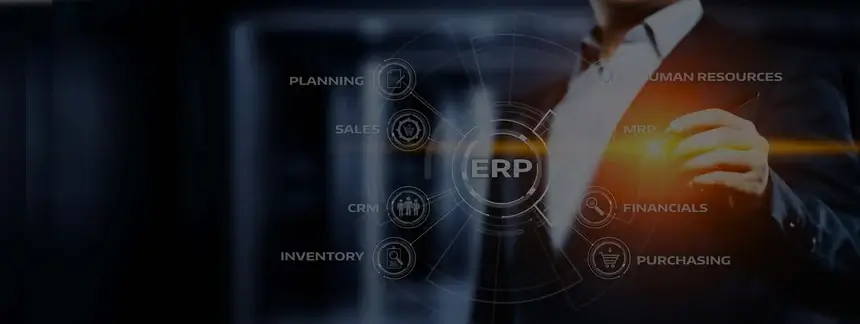Benefits of a Modern ERP System: How to Thrive in the Digital Age
It doesn’t matter if your company has reached $100 million in revenue or even $1 billion: growth trumps all and sustaining growth is hard.
“Growth creates value: companies that outperform their peers on growth post 30 percent higher total returns to shareholders,” reports McKinsey & Company.
While mature companies are well-established in their industry with a well-known product and loyal customer base, the hurdles to continued growth can come in many forms including being saddled with a legacy enterprise resource planning (ERP) system that is struggling to keep up with the times.
The reality is that upgrading to a modern ERP is essential for organizations to stay competitive, efficient, and profitable. The benefits of a modern ERP, from enhanced integration and real-time data access to scalability and AI-driven automation, far outweigh the initial investment and project timeline.
With tangible ROI statistics demonstrating increased productivity, cost savings, and revenue growth, upgrading your ERP system is not just a wise decision—it is imperative for thriving in the digital age.
Change is Hard: Many Legacy Systems are 20+ Years Old
Change is not only hard but can be expensive and time-consuming, which helps explain why many businesses today are operating legacy systems that are as old as 20 years or more.
There are, for example, a surprising number of companies still utilizing IBM AS/400 systems (first released in 1988!) or their successor Power Systems.
The average lifespan of ERP systems has been traditionally estimated at 10 to 20 years, reflecting the speed of technological advancements.
Extending your ERP system past its full life cycle makes it more likely that it will lack the flexibility and scalability needed to adapt to modern business demands.
Staying tethered to a legacy system impedes productivity, decision-making, and overall efficiency across all industries from oil and gas to aerospace and defense to manufacturing and distribution, and everything in between.
“Manufacturers focus on things like quality, equipment maintenance, profit, on-time delivery, and customer satisfaction. But, as a manufacturer, the last thing you want to think about is the age of your ERP software,” says ERP News. “Yet there you are, missing out on new features and innovations that could help your operations and your customers. But you’re not taking advantage of them. Why? Because you’re stuck in “revision prison” — a world where your company constantly fights the battle of either falling behind or taking on those painful, disruptive, and costly ERP software upgrades.”
Bottom line: Companies often don’t think about the pitfalls of their aging ERP software systems.
Addressing the Concerns of Upgrading Your ERP System
While upgrading to a modern ERP offers cutting-edge capabilities that cater to the contemporary business landscape, allowing organizations to stay agile, competitive, and future-proof – it also comes with concerns that an ERP transformation can be a daunting and costly endeavor.
Risk and cost analysis will show that relying on legacy ERP systems – that served the business well in the past – can not only hinder growth but ultimately rapid advancements in technology can render them, and your business, obsolete.
Addressing the three major concerns to an ERP upgrade include:
- Cost: Implementing a modern ERP system does require an initial investment; however, this cost must be viewed as a long-term investment that will yield significant returns over time. Modern ERPs streamline operations, reduce errors, and improve collaboration, ultimately leading to cost savings and increased profitability.
- Time: ERP upgrades can take time, especially for large enterprises. However, businesses should focus on the potential productivity and efficiency gains that a modern ERP can bring. The time invested in the upgrade will be recouped through optimized processes and faster decision-making in the future.
- ERP Return on Investment (ROI): The ROI of an ERP system can be challenging to calculate precisely, but the benefits are tangible and extensive. By streamlining operations, improving data accuracy, enhancing customer experience, and enabling data-driven decision-making, businesses can achieve significant ROI in various areas.
Keep in mind that many companies overestimate how long an ERP upgrade can take with Oracle NetSuite finding in a survey that midsize companies with $100 million to $250 million in revenue had the fastest implementation at 6.7 months. It needs to be considered that there is opportunity to introduce bias in vendor surveys, and the purpose of Oracle’s “findings” are to ultimately drive sales in their direction, but these numbers do show promise regardless.
That same survey found that nearly two-thirds of the companies that underwent ERP implantation went live in the scheduled project timeframe or sooner:
- Nearly half (49 percent) went live in the allotted time.
- 13 percent went live sooner than expected.
- 27 percent were a little late.
- 11 percent failed to go live in the time allotted.
As far as cost is concerned, expansion of the initial project scope, according to Oracle NetSuite, was the primary reason companies went over budget during implementation.
The Benefits of Upgrading to a Modern ERP System
Digital transformation is often driven by need and upgrading to a modern ERP system has many benefits that will impact people, processes, and technology:
- Enhanced Integration: Modern ERPs seamlessly integrate all business processes, eliminating data silos and enhancing cross-functional collaboration. This integration leads to faster data access, better insights, and more informed decision-making.
- Real-time Data and Analytics: A modern ERP system provides real-time access to critical business data and analytics. Real-time insights allow businesses to respond swiftly to market changes, identify trends, and optimize operations for maximum efficiency.
- Scalability: Legacy systems struggle to accommodate business growth, resulting in costly upgrades and maintenance. Modern ERPs are designed with scalability in mind, allowing businesses to expand without disruption and adapt to changing market conditions.
- Cloud-based Technology: Modern ERPs are increasingly cloud-based, offering improved accessibility, reduced infrastructure costs, automatic updates, and enhanced data security.
- Mobile Accessibility: With the rise of remote work and mobile business operations, modern ERP systems offer mobile accessibility, empowering employees to work efficiently from any location.
- Advanced AI and Automation: AI-driven features within modern ERP systems automate repetitive tasks, increase accuracy, and free up employees to focus on strategic initiatives.
- Improved Customer Experience: Modern ERPs enable businesses to gather and analyze customer data, leading to better customer insights and personalized experiences that enhance customer satisfaction and loyalty.
- Regulatory Compliance: Compliance requirements are ever-changing, and modern ERPs come equipped with features to help businesses stay compliant with industry standards and regulations.
- Reduced Downtime: Modern ERP systems are built for high availability and resilience, minimizing downtime, and ensuring uninterrupted operations.
- Faster Innovation: Upgrading to a modern ERP system enables businesses to leverage the latest technologies and innovations to stay ahead of competitors and seize new opportunities.
Envisioning the Change an Enhanced ERP Will Bring
SAP says that the key is to envision the change that an enhanced ERP will bring to your organization.
“When making a decision of this size, most companies require a cost-benefit analysis in the form of a return on investment (ROI) statement. The cost side is easy – add up the expected costs as outlined above. On the benefit side there may well be direct savings in IT costs, but enumerating the major benefits requires the company to envision how the system will change the workplace and enable higher performance, improved productivity, and better customer service,” explains SAP.
Breaking those three benefits down:
Improved Performance: Upgraded ERP systems can organize, analyze, and present data in such a way that managers can better utilize people and make decisions.
Better Customer Service: By better serving customers, companies can increase sales and profits, market share, and even increase margins because good customer service adds value for the customer without adding cost to the product itself.
Workplace Changes: Today’s systems are designed for UX or user experience providing each user with the most efficient and comfortable work screens and processes. This increased efficiency will help current employees do more and handle a higher volume of business without new hiring.
Survey Says: ERP Projects Meet Their ROI Expectations
If the movie “Jerry Maguire” was all about “Show me the money!” then ERP projects can be summed up as “Show me the ROI!”.
CIO magazine reports that 81 percent of projects met ROI expectations a year or more after go-live.
Still not convinced? Oracle NetSuite says that organizations that implement ERP experience positive ROI. Below are highlights of the benefits of the technology:
- ERP implementation led to business process improvement for 95 percent of businesses.
- In a study of companies implementing ERP, 85 percent had a projected timeline for ROI. Of that group, 82 percent achieved ROI in their expected time.
- The top three benefits businesses said they gained from an ERP system are reduced process time, increased collaboration, and a centralized data system.
- The average ROI time in a group of companies that implemented ERP was just over 2.5 years.
- The top three business goals cited for implementation are achieving cost savings (46 percent), better performance metrics (46 percent), and improved efficiencies in business transactions (40 percent).
- When asked to select areas where ERP produced ROI, the top three answers were reduced IT costs (40 percent), reduced inventory levels (38 percent), and reduced cycle time (35 percent).
Businesses that don’t Transform Risk Falling Behind
Often in business, standing still is falling behind, so organizations that fail to transform their processes risk losing ground to competitors.
“Modernizing any company’s enterprise resource planning (ERP) system can be a difficult, costly, and tedious task. That’s especially true for older companies with custom-built and entrenched legacy systems, or for those that have made acquisitions and haven’t touched the acquired ERP systems yet,” writes Jen A. Miller in CIO. “But businesses that fail to make transformations are already falling behind, and risk being surpassed entirely by their competitors if they don’t change.”
While ERP transformation has always been a game changer, it has become even more important with the pace of today’s technological innovation.
“Businesses today are dealing with technological innovations at a pace never experienced before. As B2B manufacturers shift to the cloud and add new auxiliary systems like eCommerce and global logistics applications, they face the challenge of integrating these new applications into their legacy ERP systems.,” says Manufacturing.Net. “The problem is that many manufacturers still run their businesses on legacy ERP technology, which may be 10 or more years old. Traditional ERP developers didn’t build their systems with the digital world in mind. And they certainly didn’t develop them with the functionality to integrate with new technologies like cloud applications.”
Contact ERP Technology Partners today for help in leveraging all the benefits of upgrading to a modern ERP system.

